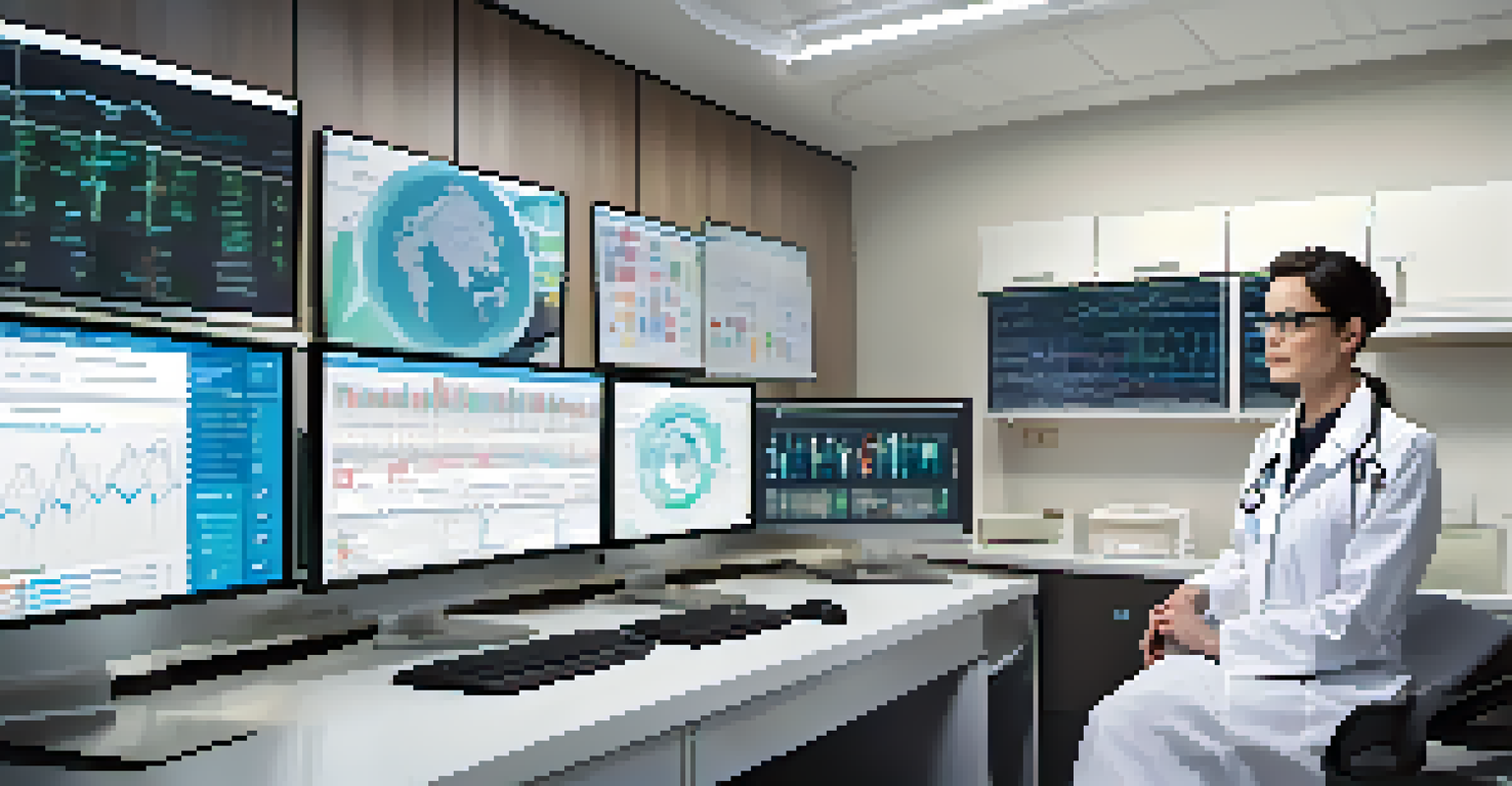Remote Patient Monitoring: Enhancing Chronic Disease Management

Understanding Remote Patient Monitoring (RPM) Basics
Remote Patient Monitoring (RPM) refers to the use of technology to monitor patients' health data outside traditional clinical settings. This approach enables healthcare providers to track vital signs, symptoms, and medication adherence from afar, making it especially beneficial for individuals with chronic conditions. Imagine being able to send your blood pressure readings directly to your doctor without needing to leave your home—this is the essence of RPM.
The future of healthcare is not just about treating illness; it's about empowering patients to take control of their health.
The technology behind RPM often includes wearable devices and mobile applications that patients use daily. For instance, a smartwatch might track heart rate and activity levels, while a smartphone app can log symptoms and medication schedules. This continuous flow of information allows healthcare providers to gain real-time insights into their patients' health, leading to more personalized and timely interventions.
By integrating RPM into chronic disease management, both patients and providers can foster a proactive approach to healthcare. Patients feel empowered to take charge of their health, while providers can respond swiftly to any concerning trends, potentially preventing serious complications down the road.
The Role of RPM in Chronic Disease Management
Chronic diseases, such as diabetes, hypertension, and heart disease, often require ongoing monitoring and management. RPM provides a bridge between patients and healthcare providers, allowing for consistent tracking of health metrics. For example, a diabetic patient can continuously monitor their blood glucose levels and share the data with their care team, enabling timely adjustments to their treatment plan.

This continuous monitoring helps identify issues before they escalate, creating a more dynamic healthcare experience. Imagine if a patient's glucose levels trend upward; their doctor could adjust their medication or lifestyle recommendations without waiting for the next in-person appointment. This proactive care can lead to better health outcomes and reduced emergency room visits.
RPM Enhances Chronic Care
Remote Patient Monitoring allows for continuous tracking of health metrics, enabling proactive management of chronic diseases.
Furthermore, RPM encourages adherence to treatment plans by keeping patients engaged in their health journey. When patients see their progress in real time, they are more likely to stay committed to their treatment, resulting in improved overall well-being.
Benefits of Remote Patient Monitoring for Patients
One of the most significant advantages of RPM is the convenience it provides for patients. With RPM, individuals no longer need to travel to a clinic for routine monitoring, which can be especially challenging for those with mobility issues or those living in remote areas. This ease of access improves regularity in monitoring and promotes better health management.
Technology is best when it brings people together, and RPM is a perfect example of that in healthcare.
Additionally, RPM fosters a sense of connection between patients and their healthcare providers. Patients can communicate their concerns and receive guidance quickly, reducing feelings of isolation that often accompany chronic illness. This supportive relationship can enhance patients' emotional well-being and encourage them to take an active role in their health.
Lastly, RPM can lead to cost savings for patients. By reducing the need for frequent in-person visits and hospitalizations, patients can save on transportation costs, co-pays, and other out-of-pocket expenses, making healthcare more affordable and accessible.
How Providers Benefit from RPM Implementation
Healthcare providers benefit from Remote Patient Monitoring by gaining access to a wealth of real-time data. This continuous stream of information allows them to make informed decisions and tailor treatment plans according to each patient's unique needs. For instance, a cardiologist can monitor a patient's heart rate trends and intervene if they notice any concerning patterns.
Furthermore, RPM can increase the efficiency of healthcare delivery. With patients regularly submitting their health data, providers can prioritize appointments and focus on those who need immediate attention. This structured approach can help reduce the burden on healthcare systems and improve the overall quality of care.
Patient Convenience and Savings
RPM provides significant convenience for patients by reducing the need for in-person visits, leading to cost savings and improved health management.
Additionally, adopting RPM can enhance patient satisfaction and retention. When patients feel that their healthcare providers are attentive and proactive, they are more likely to remain loyal to their practice and recommend it to others. This positive relationship between patients and providers is crucial for long-term health management.
Challenges and Considerations in RPM Adoption
While Remote Patient Monitoring offers numerous benefits, its adoption is not without challenges. One significant concern is the technological barrier; not all patients may be comfortable using digital tools or have access to reliable internet connections. It's essential for healthcare providers to offer support and education to help patients navigate these technologies effectively.
Another consideration is data privacy and security. With sensitive health information being transmitted online, ensuring that patient data is protected is paramount. Healthcare providers must implement robust security measures to safeguard this information and maintain patient trust.
Lastly, reimbursement policies can also pose challenges for RPM adoption. Healthcare systems need to navigate the complexities of insurance coverage for RPM services, which can vary widely. Advocating for clear reimbursement guidelines can help facilitate broader acceptance of RPM in clinical practice.
Integrating RPM into Existing Healthcare Systems
For healthcare providers looking to implement RPM, integration into existing systems is key. This often involves training staff on how to use RPM technologies and optimizing workflows to incorporate remote monitoring seamlessly. For instance, integrating RPM data into electronic health records (EHRs) allows for a holistic view of patient health.
Moreover, collaboration among healthcare teams is crucial. Physicians, nurses, and technical staff must work together to develop protocols for monitoring and responding to patient data. Regular meetings to discuss RPM findings can help ensure that everyone is on the same page regarding patient care.
Provider Efficiency and Data Access
Healthcare providers benefit from RPM through access to real-time data, which improves treatment customization and overall efficiency in patient care.
Lastly, ongoing evaluation of RPM programs is essential for success. By regularly assessing the effectiveness of RPM initiatives and making necessary adjustments, healthcare providers can continue to improve patient outcomes and experience.
The Future of Remote Patient Monitoring in Healthcare
As technology continues to evolve, the future of Remote Patient Monitoring looks promising. Innovations such as artificial intelligence and machine learning could enhance data analysis, allowing providers to anticipate patient needs even more accurately. Picture a system that alerts healthcare providers about potential health issues before they become critical—this is the potential of advanced RPM technology.
Moreover, the integration of RPM with telehealth services offers exciting possibilities. Patients can have virtual consultations with their providers while simultaneously sharing their monitored data, leading to more comprehensive and informed discussions about their health. This seamless connection can create a more cohesive and patient-centered healthcare experience.

Ultimately, as RPM becomes more widely accepted and integrated into healthcare systems, it has the potential to revolutionize chronic disease management. By empowering patients and enhancing provider capabilities, RPM can lead to a healthier future for individuals living with chronic conditions.